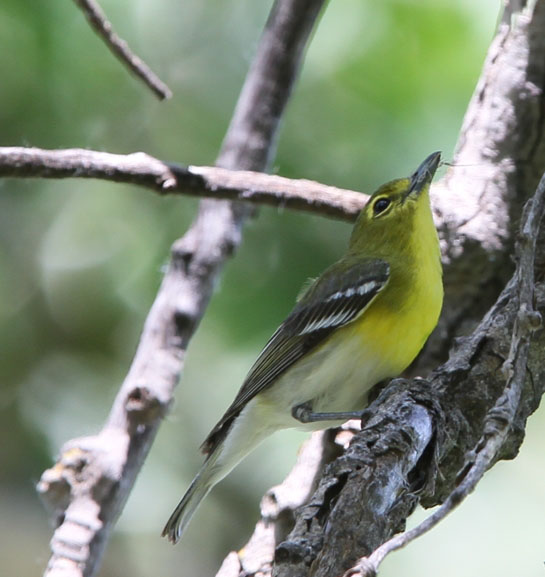June 14 update: After a violent thunderstorm struck the Chatfield Reservoir, the Yellow-throated Vireo and Plumbeous Vireo who were paired at a nest, as described in the story below, seemed to abandon the finished nest. Observers did not see the Yellow-throated Vireo, the presumed female, after that storm. The male Plumbeous Vireo was seen one morning defending the nest against a determined Western Wood-Pewee, which was stealing fibrous material from the nest. Later that afternoon, the vireo was no longer to be found. The nest was thread-bare after more material had been purloined by the pewee, which had a nest close by. Despite hope that the vireo pair might try to build a second nest, neither has been seen for more than a week. Sic transit gloria mundi!
June 4 update: Vireos Seen Sitting Down on the Job! Since the May 31 discovery of the unusual pairing of a female Yellow-throated Vireo and a male Plumbeous Vireo, each parent has been seen every day sitting patiently on their cup-like nest high in a cottonwood at Chatfield State Park. The chores of (presumed) incubation of eggs and foraging nearby for food have been shared by the closely related birds. Male Plumbeous Vireos are known to develop a “partial brood patch,” and to take turns warming the tiny eggs – usually 3 to 5 in number. (Colorado Breeding Bird Atlas I; High Kingery, editor). RMBO volunteers eagerly await the next step in nesting cycle – carrying food to hatched youngsters. Plumbeous Vireo eggs require 14 days of incubation, and the young fledge about 14 days after hatching.
A rare sight greeted 10 of us this morning as we studied the breeding birds at Chatfield State Park near Denver on an outing organized by Wild Birds Unlimited and Rocky Mountain Bird Observatory. Late morning, as we watched a singing male Plumbeous Vireo on and near a nest, Becky Campbell and Nathan McAdam spotted a different vireo high in the trees above the path. We all searched the treetops and had a good look at a Yellow-throated Vireo interacting as a pair with the Plumbeous Vireo, coming right to the nest without being chased away. Excitement filled the air – literally – at seeing vireos of different species paired up at a nest!

Yellow-throated Vireo at Chatfield State Park, Colorado, by Glenn Walbek

Yellow-throated Vireo at Chatfield State Park, Colorado, by Glenn Walbek
The Yellow-throated Vireo moved about sluggishly in the tall cottonwoods, offering multiple views. It had the sturdy vireo habitus, a heavy vireo-type bill, and a bright yellow throat and breast, fading to white on the belly and vent. Its prominent yellow “spectacles,” olive back, darkish wings with two white bars and a dark tail distinguished it from other vireos. A Pine Warbler is similar but has less distinctive spectacles, a thinner bill and is virtually unknown during our spring migration. Becky Campbell showed a Pine Warbler to 58 birders in her back yard last December and was recognized at the recent Colorado Field Ornithologists Convention with the coveted Homeowner’s Appreciation Award. Becky knows Pine Warblers, and this was not a Pine Warbler.
A little research online at Birds of North America uncovered no previous records of Yellow-throated Vireo pairing up or nesting with Plumbeous Vireo. However, such a pair was reported in Larimer County in 2002. The two species’ usual breeding ranges, separated by parts of the Great Plains, have no overlap. In the Northeast, there is only one record of a Blue-headed and Yellow-throated Vireos pairing, although they breed in the same states.
CAUTION: This is a unique situation, and the pair could produce viable hybrid young. What might they look like? The nest will be monitored closely, and I’ll send updates for RMBO’s web site. The birds are conspicuous, and I urge birders visiting the site to avoid playing recordings of either vireo’s song or calls.
~ Joe Roller, RMBO Board Director


